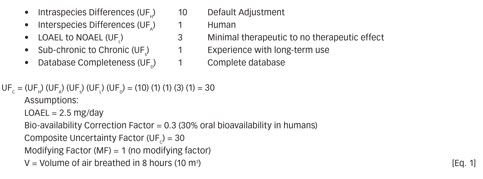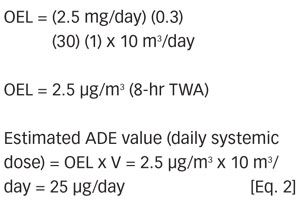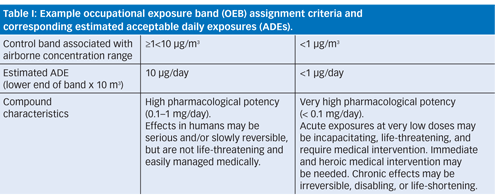EMA Guideline on Setting Health-Based Exposure Limits
The results of an industry workgroup’s examination of EMA’s guide on shared facilities are presented.
Monty Rakusen/Cultura/Getty Images

An industry workgroup comprised of toxicologists and manufacturing equipment cleaning subject matter experts was formed to examine the European Medicines Agency (EMA) shared facilities guideline, specifically the provision for alternative approaches to establishing limits and how to practically implement any proposed alternatives (1). This paper describes the outcomes of these evaluations, including alternatives for estimating health-based exposure limits using available assessments and a strategy to prioritize existing commercial products for health-based exposure limit evaluation. It provides a screening tool to identify products that require calculation of a health-based cleaning limit, and those where cleaning to existing cleaning limits (e.g., based on 1/1000th the minimum therapeutic dose) may continue. The presumption is that all newly introduced products will have formally documented health-based exposure limits. EMA was consulted during development of this paper, which is intended to support implementation of the European Union GMP Chapter 3 and 5 revisions for prevention of cross-contamination (2).
EMA published a guideline on setting healthbased exposure limits for use in risk identification in the manufacture of different medicinal products in shared facilities in November 2014 (1). The European Commission (EC) also revised related General GMP Chapters 3 and 5 in January 2015 by updating sections on prevention of cross-contamination; these revisions became effective on 1 March 2015 (2).
The EMA guide effective date was 1 June 2015 for new products and 1 December 2015 for existing products. These timelines represent a significant challenge for the industry. The EMA guide implementation timelines are aggressive considering the current number of existing products. The implications of the EMA guide are that current cleaning limits would need re-evaluation in relation to newly derived health-based cleaning limits. If revisions are necessary, then cleaning validation activities may need to be re-started for impacted manufacturing equipment. Cleaning sampling and analytical test method detection levels may need to be re-evaluated, and potentially lower detection limits established/validated. Because re-evaluation may consume significant resources, efforts need to be prioritized according to impact on patient safety.
The EMA guide uses permitted daily exposure (PDE) values as a basis for establishing appropriate limits but states that PDE values are considered synonymous with the acceptable daily exposure (ADE) values. Both represent a dose that is not expected to cause an adverse effect in an individual, even with a lifetime of exposure. The EMA guide also states that “the use of other approaches to determine health-based exposure limits could be considered acceptable if adequately and scientifically justified.”
This paper describes the potential to adopt scientifically justified and health-protective options for estimating ADE values from available assessments. It also provides examples on how to prioritize existing products and evaluate currently used cleaning limits to identify those products that require calculation of an ADE- or PDE-based cleaning limit, and those where cleaning to existing cleaning limits (e.g., 1/1000th the minimum therapeutic dose) already provides sufficient patient protection. The presumption is that all newly introduced products will have documented health-based exposure limits.
Alternative approaches for setting health-based exposure limits: Estimation of ADE values for small molecules
The goal of applying alternative approaches should be to demonstrate whether or not current cleaning practices provide a sufficient margin of safety for patient health. The approach proposed in this document provides a rationale for estimation of ADE values using existing potency and toxicological evaluations performed for worker safety purposes, followed by an evaluation of facility attributes and product mix. For example, many pharmaceutical organizations establish occupational exposure limits (OELs) for their compounds or use a control banding approach (occupational exposure bands [OEBs]) to categorize compounds of increasing severity based on their inherent pharmacological and toxicological properties and/or limited dataset. ADE values can be estimated using OELs or OEBs, and if an adequate margin of safety is identified between cleaning limits based on the estimated ADE value and maximum possible carryover based on existing cleaning limits, a formal comprehensive ADE value monograph may not be required. Adequate documentation could initially include a brief summary or spreadsheet reflecting the scientific rationale, and formal ADE values would only be needed for a subset of compounds where facility attributes and product mix do not afford an adequate margin of safety. The evaluation approach should be documented for each site and included in plans available for review by regulatory inspectors.
Identifying the most hazardous drugs. Prior to issuance of the EMA guideline on setting healthbased limits, categories of drugs were identified that have the greatest concern (e.g., “certain hormones, certain cytotoxics,” etc.); however, specific criteria were never provided. The International Society for Pharmaceutical Engineering (ISPE) Risk-MaPP baseline guide outlines example characteristics of compounds of traditional concern that could benefit from further review (3):
- Genotoxic (specifically mutagenic) compounds that are known to be, or highly likely to be, carcinogenic to humans.
- Compounds that can produce reproductive and/or developmental effects at low dosages.*
- Compounds that can produce serious target organ toxicity, anaphylaxis, or other significant adverse effects at low dosages.* * e.g., clinical doses <1–10 mg/ day or dosages in animal studies <0.1–1 mg/kg/day
The threshold of toxicological concern (TTC) concept may also be useful to estimate ADE values and applies to products containing mutagenic active ingredients (ADE=1 μg/day), those that are potent or toxic (ADE=10 μg/day), or those that have no prior evidence of these properties (ADE=100 μg/day) (4). In principle, each of these approaches can be used to identify hazardous drugs for risk assessments and, if scientifically justified, can be used for the derivation of healthbased cleaning limits. Identification of a compound as a hazardous drug should not automatically lead to strict control solutions, because it addresses only hazard. A risk assessment should be completed before conclusions can be made about risk and the need to modify controls.
Alternative approach 1: If I have an OEL. ADE or PDE value derivation and OEL derivation share the same scientific basis (e.g., the same method to define the point-of-departure [PoD]), with some differences in the respective adjustment factors related to the different exposure scenarios or regulatory context. By comparing the respective standard adjustment factors, it is possible to define the systematic difference between the two calculations. If this systematic difference is adequately evaluated and the OEL derivation is scientifically justified, estimation of the ADE from the available OEL could meet expectations to derive health-based cleaning limits, at least on an interim basis to support prioritization and assessment of existing cleaning limits.
The EMA guide acknowledges that “good quality human clinical trial data is highly relevant” to the assessment for ensuring patient safety. Following the publication by Fourman and Mullen in 1993, many firms have used a minimum therapeutic dose approach (e.g., 1/1000th of the minimum therapeutic dose) to calculate cleaning limits (5). The existing OEL monograph, if available, can be used as a screening tool to determine if this approach is health-protective. OEL monographs typically include a potency and toxicological evaluation of relevant nonclinical and clinical data. In the workplace, compoundrelated effects (including intended pharmacology and unwanted toxicity) are considered adverse. Many products have a favourable therapeutic index, which means that the pharmacological activity is the most sensitive effect. However, EMA doesn’t address derivation of an ADE from clinical data. Because the OEL is frequently derived from the minimum therapeutic dose, it is reasonable to deduce that the ADE value based on 1/1000th the minimum therapeutic dose is sufficiently conservative for most compounds. ISPE Risk-MaPP outlines science-based adjustment factors that support this assumption. For example, a lower composite adjustment factor (i.e., 10 to account for intra-species differences and 3 to extrapolate to a no-effect level) can be scientifically justified if using the minimum therapeutic dose as the PoD for a product with a reasonably robust dataset (e.g., late- to commercial-stage compound). Therefore, when the human dose information is used as the PoD for OEL derivation, the minimum therapeutic dose cleaning limit approach may be considered health-protective, and no additional value would be derived by proceeding to a formal ADE derivation.
The exception would be compounds (e.g., classical oncology compounds) with an unfavourable therapeutic index that may cause unwanted or even serious adverse health effects at exposures near or below the indicated minimum therapeutic dose. A mutagenic carcinogen administered at a dose of 750 mg/day, for example, would result in a limit of 750 μg/day using the 1/1000th approach, which is almost three orders of magnitude higher than the TTC level of 1 μg/day using Dolan et al. (or 1.5 μg/day under ICH M7) (4, 6). In these cases, a review by a toxicologist is recommended. When the OEL is calculated using a nonclinical PoD (e.g., repeat-dose toxicity or reproductive toxicity in animals), or involves route-to-route extrapolation, then further review by a toxicologist is also recommended to determine an appropriate ADE value.
Example of an estimated ADE value calculation using data from the OEL monograph for Compound A. The following example illustrates the calculation of an OEL for Compound A using the minimum therapeutic dose of 2.5 mg/day as the PoD. All relevant nonclinical, clinical, and post-marketing data were evaluated. The details are provided to show the similarity to ADE derivation while highlighting that assessment factors used might differ.
The OEL incorporates a composite adjustment factor (AF) of 30, derived as follows (see Equation 1- UF is uncertainty factor; LOAEL is lowest observed adverse effect level; NOAEL is no observed adverse effect level).

For the calculation of the OEL, a bioavailability correction factor of 0.3 is included in the numerator to account for oral bioavailability in humans (30%). Therefore, an ADE estimated from the OEL is conservative (i.e., approximately three-fold lower than needed) if the oral route of exposure is applicable for the cross-contamination scenario (see Equation 2-TWA is time weighted average).

By comparison, 1/1000th the minimum therapeutic dose is 2.5 μg/day (2.5 mg/day/1000), which is 10 times lower than the estimated ADE value. Therefore, the existing cleaning limit is acceptable, and development of a formal ADE value is not a high priority at this time.
Alternative approach 2: What if I don’t have an OEL but I do have an OEB? Many companies assign new compounds to an OEB, or equivalent designation by airborne concentration ranges, to provide guidance on safe handling before sufficient data are available to establish a numerical OEL. The OEB is assigned based on the compounds’ inherent pharmacological and toxicological characteristics, including the intended use, mechanism-of action dose-response, and safety pharmacology studies. One option is to use the OEBs to estimate ADEs for the most hazardous subset of compounds (i.e., those with the most restrictive OEBs).
Example OEB assignment criteria are provided in Table I corresponding to ADE values of 10 and 1 μg/day corresponding to respective OEBs of ≥ 1 <10 μg/m3 and <1 μg/m3 because it is assumed that 10 m3 are breathed during the workday. These are the same values that would be derived using the TTC concept outlined in Dolan et al. (4). Application of these default values presumes that sufficient compound-specific data are not available to estimate an ADE (5). The examples focus on “potent” or “high containment” compounds, but in practice, the principle would still hold across less restrictive bands. As with application of the OEL, a bioavailability correction could be considered if the compound is anticipated to have extremely low bioavailablity via a relevant route.

CLICK FIGURE TO ENLARGE Figure 1: Example decision tree for evaluating effectiveness of existing cleaning limits using the occupational exposure limits (OEL) or occupational exposure bands (OEB). PDE is permitted daily exposure. ADE is acceptable daily exposure. EHS is environmental health and safety.

How can consistent screening to evaluate the effectiveness of existing cleaning limits using the OEL/OEB be implemented? Figure 1 provides an example decision process for systematic determination of whether traditional cleaning limit calculations are adequate using the OEL and OEB. The decision tree shows that use of OEL and application of 1/1000th the minimum therapeutic dose approach could be acceptable under the following conditions:
- For existing commercial products where existing cleaning limits are based on the 1/1000th approach
- If an OEL monograph including toxicological evaluation of relevant nonclinical and clinical data is available
- If the pharmacological activity is the most sensitive (critical) effect.
Large molecule considerations
The EMA guide states that “determination of health-based exposure limits using PDE limits of the active and intact product may not be required” for macromolecules (proteins and peptides) (1). When macromolecules are exposed to pH extremes and/or heat, they rapidly degrade and denature and are considered pharmacologically inactive. Only breakdown products such as smaller peptide fragments or amino-acid derivatives formed due to protein hydrolysis would be present after cleaning under conditions that are shown to effectively degrade and inactivate protein-based products.
In these scenarios, health-based exposure limits of the active products are no longer relevant. An experimental approach and analytical methods for assessing degradation and inactivation of the API during cleaning, and an approach for setting safety-based acceptance limits for inactivated product and process residuals are described in separate industry publications (7, 8). However, if effective protein degradation and inactivation could not be demonstrated in the cleaning studies, cleaning limit should be based on PDE.
Conclusion
The proposed screening tool and methods for estimating ADE values are appropriate for implementation of the EMA guide with the goal of ensuring health-protective cleaning limits. It is valuable to note that compound-specific hazard is not the only concern as the hazard of all compounds in the matrix must be considered in order to calculate the worst-case cleaning limit for all Product A-to-Product B changeover permutations. Hence, implementation of worst-case permutations affords an additional level of safety for many limits. Further assurance is provided on completion of the cleaning; when the equipment is dry, a visual inspection is typically performed for those surfaces that can be visually inspected.
References
1. EMA, Guideline on Setting Health-Based Exposure Limits for Use in Risk Identification in the Manufacture of Different Medicinal Products in Shared Facilities (EMA, 20 Nov. 2014), .
2. EU, EudraLex-Volume 4 Good Manufacturing Practice (GMP) Guidelines, Chapters 3 (Premises and Equipment) and 5 (Production), Revisions (January 2015).
3. ISPE, Volume 7: ISPE Baseline Guide: Risk-Based Manufacture of Pharmaceutical Products (Risk-MaPP) (ISPE, September 2010).
4. D.G. Dolan et al. Regul. Toxicol. Pharmacol. 43, 1–9 (2005).
5. G.L. Fourman and M.V. Mullen, Pharm.Technol., April, 54–59 (1993).
6. ICH, M7 Assessment and Control of DNA Reactive (Mutagenic) Impurities in Pharmaceutical to Limit Potential Carcinogenic Risk (ICH M7), Step 4 version (ICH, 23 June 2014, Adopted by EMA September 2014).
7. A. Mott et al., Journal of Validation Technology 19 (4) (2013).
8. R. Sharnez et al., Journal of Validation Technology 17 (4) (2012).
About the Authors
Andrew Teasdale is a principal scientist at AstraZeneca, andrew. teasdale@astrazeneca.com; Bruce D. Naumann is executive director, Toxicology, Merck & Co.; Gretchen Allison is a senior director in Global Quality Operations at Pfizer Inc.; Wendy Luo is an associate director, Drug Safety Evaluation, Bristol-Myers Squibb; Courtney M. Callis is research scientist, Health/ Safety/Environmental, Lilly Research Laboratories; Bryan K. Shipp is director, Risk Management, Pfizer Inc.; Laura Rutter is SM manager, Analytical Services, GlaxoSmithKline; and Christopher Seaman is senior manager, Occupational Toxicology, GlaxoSmithKline.
Article DetailsPharmaceutical Technology
Vol. 40, No. 1
Pages: 58–62
Citation:
When referring to this article, please cite it as A. Teasdale, "EMA Guideline on Setting Health-Based Exposure Limits," Pharmaceutical Technology 40 (1) 2016.
